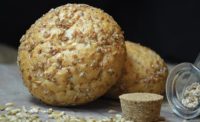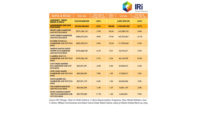State of the Industry 2017: Building creativity into healthier, distinctive buns and rolls
Various approaches to premium and differentiated offerings drives opportunity in buns and rolls.


courtesy of Delavau

courtesy of National Honey Board

courtesy of Sasa Demarle Inc.

courtesy of Koenig Bakery Systems




Fresh bread and roll sales

Bun sales

Baked goods sales











The buns and rolls segment showed pockets of growth, with a mix of gains and losses across the board. While traditional products still maintain the lion’s share of the buns and rolls category, growth in gluten-free, organic and healthy options are starting to pick up. The better-for-you trend is moving toward use of multiple types of whole grains and other nutritious ingredients like seeds.
Overview | Bread | Tortillas | Sweet Goods | Snack Cakes | Pizza | Desserts | Cookies | Buns & Rolls | Bars | Breakfast Products
Market data
The “all other” fresh rolls/bun/croissants segment within fresh bread and rolls—the largest in the buns and rolls category—saw the most growth, up 3.02 percent in dollar sales to $2.1 billion for the 52 weeks ending March 19, 2017, per IRI, Chicago. The second-largest segment in buns and rolls, hamburger and hot dog buns, dropped 1.34 percent in dollar sales for the period, hitting $2.0 billion.
Other gains included refrigerated dinner/sandwich rolls/croissants, up 1.00 percent to $2.0 million, and frozen fresh baked bread/roll/biscuit, up 1.61 percent to $771.5 million.
Private label sits in the top slot for every segment in buns and rolls except for frozen fresh baked bread/roll/biscuit, where it’s No. 2. But private label was not a top growth leader across the category.
In all other rolls/bun/croissants, King’s Hawaiian is quickly gaining on private label, seeing growth of 14.58 percent to $545.6 million. Campbell Soup Co.—home to Pepperidge Farm—also saw strong gains in the segment, up 10.22 percent to $116.7 million. Campbell also saw the best growth in hamburger and hot dog buns, up 17.00 percent to $91.7 million.
Top growth in frozen fresh baked bread/roll/biscuit was seen by T. Marzetti, up 4.58 percent in dollar sales to $325.4 million. Its segment-leading New York Bakery brand of frozen garlic bread products was up 4.82 percent to $209.00 million, per IRI.
Looking back
The top-growing bread options on U.S. menus over the past four years are gluten-free (2,630 percent), bao (91 percent), pretzel (91 percent), brioche (85 percent) and potato buns (82 percent) and sandwich rolls, according to the MenuTrends database of Datassential, Chicago.
“Some of these are further along on menus than others,” says Mike Kostyo, senior publications manager, Datassential. “Gluten-free buns are only on 2 percent of U.S. menus, for instance, while pretzel buns are on 10 percent of menus and brioche is on 12 percent of menus. We’re also seeing a lot more alternative grain use in breads. Chia, flax, whole grains and sprouted grains are all trending up in breads/buns/carriers on menus.”
Buns and rolls are following many of the health-and-wellness trends occurring in the industry today. “For buns and rolls, this means more natural, gluten-free and organic callouts, as well as the use of different types of grains—whole grain, multigrain, whole wheat. Quality—a top-of-mind menu attribute for consumers—applies to buns and rolls with the use of premium, artisanal types such as brioche, potato, pretzel and sourdough,” says Laura McGuire, director, shared content services, Technomic, Chicago.
In June 2016, Pepperidge Farm released new Farmhouse hamburger buns, including a Stone Ground Wheat variety, designed for “bigger, bolder burgers,” as noted on front-of-pack messaging. And in late 2016, Bakerly released its “family” line, which included non-GMO brioche hot dog/sausage rolls.
Non-GMO and organic options continue to attract consumers who value these attributes, according to Mark Stavro, senior director of marketing, Bunge North America, St. Louis. “People continue to seek new varieties and eating experiences. Ancient grains such as quinoa, sorghum and millet align with both of these trends. They are non-GMO and deliver a desirable, wholesome eating experience in buns and rolls,” he says.
Brandon Iacometta, marketing director, Sasa Demarle, Inc., Cranbury, NJ, sees a big increase in the use of various grains and seeds (pumpkin, sunflower, sesame, flaxseed). Also, there is more focus on buns and rolls being part of the meal itself, as opposed to just a neutral delivery vessel for the sandwich. “A perfect example of this is the pretzel bun, which you see everyone doing now. There is a real focus on the flavor of the bun itself,” he says.
Rich Breeswine, president and CEO, Koenig Bakery Systems, Ashland, VA, sees trends toward the production and consumption of several new bun and roll product groups. These include brioche hamburger buns, pretzel buns, challah, fusion products and specialty grain rolls.
In terms of hamburger buns, high-quality brioche buns are very popular now, Breeswine adds. German-style pretzel buns, pretzel sub rolls and pretzel dinner rolls also are in high demand because of their distinctive look and taste. “Not only are bun styles and tastes important, we also consider processing trends, such as for frozen buns and rolls. Grocery stores, bakeries and convenience stores want to offer their customers fresh buns at all times, which is possible with an optimized cooling chain. As a supplier of baking equipment, it is our challenge to provide machinery for high-quality roll production for baked, half-baked and frozen buns,” he says.
Sweetener choice is also seeing scrutiny. Last year, McDonald’s rolled out new sandwich buns that contain no high-fructose corn syrup for use with multiple menu items. The artisan roll introduced in 2015 never contained high-fructose corn syrup.
Sweetener selection can impact the appeal and eating quality of buns and rolls in retail and foodservice, according to Catherine Barry, director of marketing, National Honey Board, Firestone, CO. “Consumers have always sought a sweet flavor profile to their buns, rolls and breads, so the first priority is using a sweetener that can deliver an exceptional flavor profile. Secondly, the fact that consumers and foodservice operators are shifting their preferences to clean-label products has made the choice of sweetener even more important. Balancing a sweet flavor profile and a clean label requires the use of a sweetener such as honey, which is all-natural, delivers exceptional flavor and helps market products.”
Looking forward
In terms of forward-looking trends, the marketplace will see more ethnic twists for breads in general, such as tortas, pitas and flatbreads, as well as more flavors added to buns and rolls, according to McGuire. Brioche also continues to gain traction. She offers these two examples in the hamburger bun category:
Carl’s Jr. and Hardee’s recently introduced the Baby Back Rib Burger at participating locations. The item features a charbroiled beef patty, charbroiled boneless baby back ribs, barbecue sauce, deep-fried onion strings and pickles on a brioche-style bun.
Wendy’s recently unveiled the Fresh Mozzarella Chicken Sandwich featuring mozzarella, balsamic diced tomatoes, spring mix, basil pesto and a grilled chicken fillet on a toasted garlic brioche bun.
Premium buns and rolls hold appeal, notes Angie Singer, director of sales and marketing, Delavau Food Partners, Philadelphia. “Bakers should focus their marketing and product development efforts on highlighting the sensory appeal of their buns and rolls,” she says. The company’s Encore Soft improves freshness and eating quality, Encore Strong improves dough strength and Encore Relax improves dough extensibility.
Looking ahead, Stavro says the greatest opportunity for growth in the buns and rolls category involves creating new, differentiating options that appeal to ongoing demand for organic and non-GMO options.
Harry Jacoby, president, MIWE America, Hillsborough, NJ, says the marketplace wants creativity and higher-quality bread products to enhance meals. “By creativity, I mean doing a bun or roll differently than the ordinary. Don’t be plain vanilla. Be creative. Brioche buns, ciabatta, multigrain and various types of wheat can make the product taste better, be more desirable and even healthier.”
Overview | Bread | Tortillas | Sweet Goods | Snack Cakes | Pizza | Desserts | Cookies | Buns & Rolls | Bars | Breakfast Products
Looking for a reprint of this article?
From high-res PDFs to custom plaques, order your copy today!

















